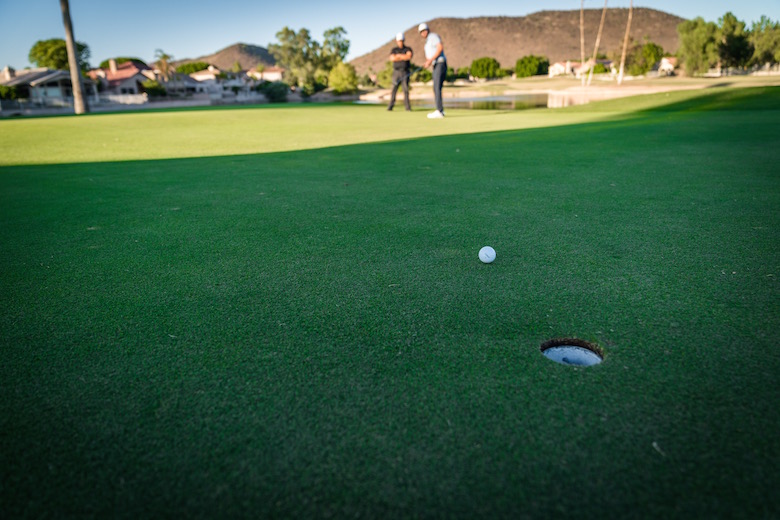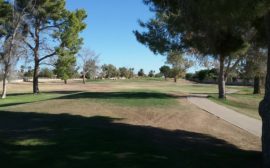Being a well-rounded golfer means knowing how to work with different types of golf course grass. In Arizona, for example, you have to deal with Bermudagrass and Ryegrass. Rye is the winter grass and Bermuda is summer grass. Poa annua (pronounced Pa Anna) grass is prevalent in most parts of the country and is usually mixed with Bentgrass, except for in California.
Types of Golf Course Grass
I am no agronomist, but anyone that plays golf for a living will know a lot about grass. Golfers and grass go hand in hand. Here are the most common types of golf course grass.
Poa Annua:
Also called Poa, is a type of annual bluegrass or meadow grass. It is a low-growing turfgrass that can be found in more temperate climates. Think Northern California, Northwestern USA, Northeast, Midwest and so on. Pebble Beach, Torrey Pines and Olympic Club are known for this type of grass.
Bermudagrass:
This is an exceptional heat- and drought-tolerant grass. As a “warm season” grass, you will typically find this in warmer climates: Southern California, Arizona, Nevada, Florida, Carolinas.
Bentgrass:
A “cool season” grass, it does great in cooler climates and not as well in very warm climates. If you have played in South Carolina in the summer, you may have noticed those huge fans on the greens. They keep air flowing around the greens, so the bentgrass does not die off.
Perennial Ryegrass:
This type is a perennial grass. You will see this used in any areas that transition from Bermuda in the summer to Rye in the winter. It is a winter grass or a cool-summer grass.
Zoysia:
This is a world-class playing surface. It makes the ball look as though it is a sitting on a tee! Courses like Cordillera Ranch in Texas and Olympic Course in Rio De Janeiro use this type of grass. It uses 30-40% less water and fertilizer and is also drought-tolerant.
Types of Golf Course Grass: Grain & Your Chipping
Golfers should pay close attention around the greens when chipping. Some grasses will make the ball sit up perfectly (where it looks to be on a tee), and others will make it sit down and look like it may be sitting in a hole.
Another important grass consideration? The grain. We are not talking Wheaties here or pasta, we are talking grass! Ok, seriously though. Here’s what it means and tests for your chipping.
Into the Grain
There is a tendency for the ball to be sitting into the grain around the greens. Into the grain is when the ball is sitting down and the blades of grass are growing back toward the ball. A good test: Take a few chips next to your ball and if it digs into the grass and doesn’t skip, you are likely into the grain.
Down Grain (With the Grain)
This is when the grass is going the same direction that you are chipping. Another way to think about it: The blades of grass are usually pointing toward the hole. One thing that can happen when you are down grain is that the bounce of the club can slide too much and you can hit it further than you thought. It’s something to account for when hitting these chips. Less bounce is usually better. (Bounce is the other number on your wedge. 6, 8, 10, 12 degrees are common.)
Bermudagrass and bentgrass have plenty of grain and you’ll need to take bounce into consideration. You usually do not see this with Ryegrass or Poa.
Types of Golf Course Grass: Grain & Your Putting
Before you head out the course, you should have a pretty good idea of what type of golf course grass you are playing on. You can even test the grain on the putting green. How to tell? If the putting green looks to be a light and dark color, it has grain!
Which direction is grass growing?
This can be tricky and takes practice. Competitive golfers be aware: You are not legally able to put your palm down and feel the grass in tournament play. But, hey, if you are not out there competing in events, feel free to touch that grass! Again, you need to assess the situation when you are walking up to the green. If you see two different colors of grass – light and dark – pay attention.
Light grass (tan or light brown color):
- You are down grain
- Putt will be faster
- If you are chipping down grain, it will run out more (faster)
- Will not break as much if there is looks to be break. Safe bet: cut the break in half
Dark grass (dark green)
- You are into the grain
- Putt will be slower
- Hit the putt harder
- If you are chipping into the grain, the chip will stop quicker
- Putt will break more than if it was down grain – keep your pace up and it will not!
Cross-grain putts
Remember: Everything is based on pace. If the greens are slower, the grain effects your putt more than if the greens were faster. Cross grain is when you are putting and the grain is either coming off of the right or the left. On a straight putt, it will only effect this slightly.
If your pace is correct, it should not affect it much at all. If you are a die putter then, yes, it will effect you more than someone who hammers the ball into the back of the hole. This is the reason you see most professional golfers ram putts in from 5 feet. Because they do not want the grain to effect their putts. So if you are worried about grain, try hitting your putts firmer. If you are reading this and are not sure how to read grain, you probably do not need to know because you hit your putts firm enough already!
I hope this helps you become a better putter and green reader. Let me know if there’s any questions about the types of golf course grass, reading the grain and more in the comments below.
And here’s another post that might help your putting stroke, training aids like Laser Putt Golf.




